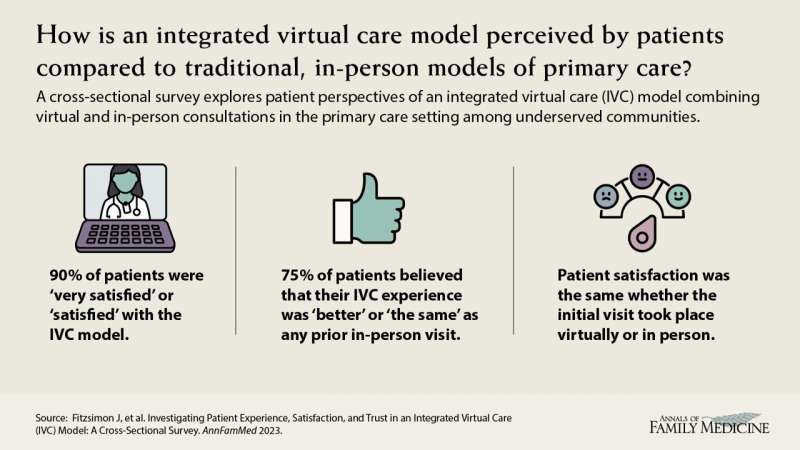This article has been reviewed according to Science X's editorial process and policies. Editors have highlighted the following attributes while ensuring the content's credibility:
fact-checked
peer-reviewed publication
trusted source
proofread
Canadian patients report high levels of satisfaction from an integrated model of virtual and in-person care

In an effort to increase access to care in underserved communities, researchers from the University of Ottawa evaluated the implementation of an integrated virtual care (IVC) model. Their study evaluated the overall experience and satisfaction of patients receiving care through a combination of virtual and in-person visits.
A secondary aim was to compare the experiences of patients who had been previously seen in person by a family physician before transitioning to the IVC clinics with those who met their family physician virtually for the first time in their virtual appointment at participating clinics.
The IVC model helps alleviate the burden on overwhelmed primary care clinicians by leveraging telemedicine technology, allowing family doctors located outside the community to provide care to patients remotely.
By utilizing secure messaging, telephone consultations, and video appointments, the IVC model expands the pool of available family doctors, ensuring patients can access care even when local clinicians are overburdened. In-person care is provided by physicians, nurse practitioners and other allied health professionals including community paramedics within the local family health team.
Using a cross-sectional online survey administered to 121 patients, the researchers determined that across all groups, 90% of patients were very satisfied or satisfied with care from their family physician, and 89% with care from their allied health team.
When comparing previous health care experiences, 75% of respondents believe that their encounters with IVC were better than or the same as any prior, in-person health care encounters. There was no difference in satisfaction or trust between patients who had a previously established in-person relationship with their doctor and those whose first visit was virtual.
Health care systems, both in Canada and globally, have long faced challenges in delivering timely and continuous primary care to their populations. The COVID-19 pandemic further exacerbated these difficulties, prompting health care organizations to establish virtual care networks to address the evolving needs of patients and ensure access to health care services.
Researchers found across all groups, 90% of patients were very satisfied or satisfied with care from their family physician, and 89% with care from their allied health team. When comparing previous health care experiences, 75% of respondents believe that their encounters with IVC were better than or the same as any prior, in-person health care encounters. Those levels were comparable to traditional in-person models of primary care.
The research is published in The Annals of Family Medicine journal.
More information: Samantha Buchanan et al, Investigating Patient Experience, Satisfaction, and Trust in an Integrated Virtual Care (IVC) Model: A Cross-Sectional Survey, The Annals of Family Medicine (2023). DOI: 10.1370/afm.2978





















